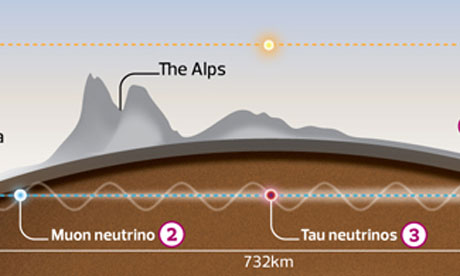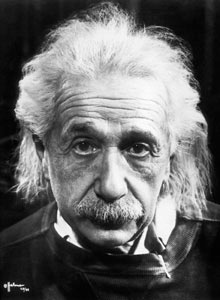爱因斯坦教授,您老可以放心了。E仍旧等于mc2。应该是这样的……
译者 seez_franco
Professor Einstein, you can relax. E still equals mc2. Probably …
爱因斯坦教授,您老可以放心了。E仍旧等于mc2。应该是这样的……
Renowned physicist Frank Close urges caution before we abandon the theory of relativity and prepare for time travel
你也打算抛弃相对论了?开始积极准备时光旅行了?知名物理学家弗兰克•克洛斯劝大家三思而后行!

欧洲粒子物理研究所中微子实验的部分示意图(译者注:图中三条注解分别为:阿尔卑斯山,②μ粒子,③t粒子)
The barman said: "Sorry, we don't serve neutrinos." A neutrino enters a bar.
酒保说:“不好意思,我们这里不接待中微子。”一个中微子走进一间酒吧。
This is but one of many tweets inspired by the news that neutrinos – ghostly subatomic particles – may travel faster than light. If so, science fiction could become science fact, with wonderful paradoxes such as effects preceding their causes. One example would be the punchline preceding the story (in case, like me, it took a while for you to decode the joke).
有关中微子(一种在原子内部神出鬼没的微粒)的运动速度可能比光速还快的新闻引发了无数条与之相关的推特,上面援引的就是其中之一。若消息属实,科幻小说里那些桥段,比如先果后因这类神叨叨的悖论就都成了科学事实。举一个最典型的例子,故事末尾的点睛之笔将出现在故事诞生之前(就像我一样,免得你花大把时间去琢磨这则笑话到底为什么好笑)。
As a scientist I have grown up to believe this law of nature: the only thing that travels faster than light is a rumour. The story that scientists at Cern, Europe's giant particle physics laboratory near Geneva, had apparently created neutrinos that travelled faster than light, hit the news on Friday morning while I was half asleep and seemed to be the latest example of this law.
作为一个科学家,我从小到大一直坚信这样一条自然法则:世界上唯一比光速还快的就是流言散播的速度。据称,来自于日内瓦附近的欧洲粒子物理研究所的科学家已然创造出了运动速度超越光速的中微子。这则消息不久便出现在周五的早间新闻里,而那个时候,我还在半梦半醒间徘徊。这个新鲜出炉的案例基本可以算作上述法则的不二例证。
But as I awoke, and the story refused to go away, I began to panic that I would have to rewrite my book Neutrino – which it seemed was rapidly being overtaken by events. My only consolation was that this revision would be but a small tremor in the unimaginable change to our understanding of life, the universe and, indeed, everything, if this claim turned out to be true. The physics textbooks in the libraries of the world would be wrong; the foundations of science would crumble. Particles travelling faster than light, capable of carrying information, would alter everything. So, what's going on and why does it matter?
不幸的是,醒来后我发现这条新闻依旧“阴魂不散”。于是,我开始担惊受怕起来——这意味着我可能得给自己的得意之作《中微子》来个大返工。这个突如其来的消息就好比半路杀出的程咬金,让我的写作内容一下子变得不对头。唯一能让我感到些许安慰的是,一旦这种说法被证明是正确的,那么,我作品的修订版或许能在这场完全颠覆我们以往对生命、宇宙,或者更确切地说,这世上存在的一切的理解的变革中引发一阵小小的骚动。全世界图书馆里的教科书或许是错的;科学的奠基或许将土崩瓦解。能够携带信息,并以超越光速的速度运动的量子或许会改变一切。好吧,问题来了:如今到底发生了什么了?它又为何事关重大?
Einstein's theory of relativity was one of the great revolutions of 20th-century thought, and arguably the greatest theoretical construct of the human mind. When Isaac Newton built his laws of motion in the 17th century, he imagined space and time as some invisible matrix through which we pass without changing them. The metronome ticks steadily on as we move through a permanent static three-dimensional space. Einstein's vision was that space and time are fluid, intertwined, affected by our motion: the faster you move, the slower you age. This has many wonderful implications, such as the puzzle of the twins – Tweedledum who stays at home while Tweedledee takes a high-speed gap year and returns home wiser but, surprisingly, younger than his sibling.
爱因斯坦的相对论是20世纪最为重大的理论变革之一,也可以说是人类思想的最伟大的理论奠基。早在17世纪,牛顿创立了牛顿运动定律。他将时间和空间看作一个矩阵,当我们从这个矩阵中穿过时,时间和空间不会发生改变。当我们经过一个永恒静止的三维空间时,节拍器正有规律地滴答作响。然而,在爱因斯坦看来,空间和时间是流动的,相互缠绕的,而且它们还受到运动的影响:你移动的速度越快,就老得越慢。这种理论引出了一连串奇思妙想,比如双胞胎之谜——叮当弟乖乖在家做宅男,而叮当兄迈出家门开始了他的间隔年(译者注:中学毕业至开始上大学之间的非受教育时期,通常为一学年)极速之旅。当哥哥归来时已满腹经纶,但神奇的是,他竟然比在家的弟弟年轻。
The fact that space and time are elastic, stretching and warping in synchrony with our passage, is weird, but inescapably true. The beams of particles at Cern, travelling within a mere fraction of light speed, arrive at their destination on time only when the subtleties of relativity are included in the accounting. GPS satellites locate you precisely, but have to include Einstein's arithmetic in the calculations. Some experiments at Cern agree with the predictions of relativity to better than one part in a trillion – that is like measuring the distance across the Atlantic Ocean to better than the width of a human hair – but only when relativity is taken into account.
时空是有弹性的,在我们穿越时空的过程中它会延伸、扭曲,这种说法听起来荒谬,却是无可否认的事实。在欧洲粒子物理研究所的实验室里,粒子束正以比光速小得多的速度运动。然而,如果不用相对论的相关原理来解释这种运动,那么这些粒子束就不能准时到达目的地。全球定位系统卫星能精确锁定你所在的位置,然而,当它进行定位计算时,也必须用到爱因斯坦提出的运算方式(即相对论)。在欧洲粒子物理研究所进行的部分实验也表明,利用相对论的相关原理所做出的科学预判具有比一万亿分之一还要高的精确性。这就好比测量大西洋的跨度时把精确度提升到一根头发丝那般粗细,但前提是你必须采用相对论进行计算。
For scientists certainly, and for many of us, perhaps surprisingly, Einstein's theory of relativity is needed to keep track of our daily affairs.
爱因斯坦的相对论需要紧跟时代的步伐。对科学家来说这是自然而然的,不过你也许想不到,对我们中的大多数人来说,这种观点同样在理。

艾尔伯特•爱因斯坦认为没有什么能够超过光速。
What has any of this to do with the speed of light?
以上这些跟光速有什么关系呢?
Einstein's edifice is constructed on an experimental fact: that the velocity of light is independent of your own motion. Whether you are moving towards the source, or away from it, or are stationary, doesn't matter: speed of light is universal. This is counterintuitive. A fast racing car overtakes a slower one more gradually than it does the static spectators at trackside; however, a light beam passes everyone the same – spectators or Lewis Hamilton would measure the same speed. Counterintutitive certainly, but true, and it led to Einstein's world-view. And one of the basic consequences of Einstein's theory is that the speed of light – in a vacuum – is nature's speed limit. Nothing can travel through a vacuum faster than light.
爱因斯坦的理论大厦基于这样一个实验事实:即光速与你自身的运动速度无关。不论你是向着一个原点移动,还是远离这个原点,或是静止不动,这些都无关紧要:光速是一个衡量。这是反直观的。一辆跑得较快的赛车若要超越一辆慢车需要一个循序渐进的过程;与之相比,这辆快车驶过赛道边上的观众所需要的时间就少得多了。光束却并非如此,它以相同的速度经过每个人——不论他是场外观众还是刘易斯•汉密尔顿(译者注:F1车手兼世界冠军)。虽说该理论具有反直观性,但它的真实性却毋庸置疑,同时它也透露了爱因斯坦的世界观。由爱因斯坦的这个理论所推导出的基本结论中包含了这样一条,即真空中的光速是自然界中的极限速度。在真空中,没有什么东西能比光跑得更快了。
Has Cern overthrown this paradigm? I doubt it. Light travels slower through water, glass, even air, than through a vacuum. Radio waves do, too. So light can be slowed down, but not sped up: the vacuum is nature's open road where light travels at the speed limit. We need to be careful when asking what exactly has the Cern experiment done, or, more pertinently, how did it do it?
欧洲粒子物理研究所的研究成果会颠覆这种既定逻辑吗?很难。光在水、玻璃,甚至是空气中的传播速度比起在真空中慢得多。无线电波亦然。所以说,光速可以减慢却不能加快:真空好比是自然界的康庄大道,光便以其极限速度疾驰在这条大道上。欧洲粒子物理研究所的实验室里到底发生了什么?或者更恰当地说,那些实验究竟是如何操作的?当我们问起这些问题时,务必要小心谨慎。
Cern produces beams of neutrinos, ghostly particles that can travel through the earth as easily as a bullet through a bank of fog. A beam travels down through the surface of the Earth in a straight line, the Earth's surface curving upwards away from it initially, eventually bending downwards until, 730km later, at Gran Sasso, a laboratory near Rome, the neutrino beam re-emerges. This journey has taken about 1/500th of a second.
欧洲粒子物理研究所研制出了中微子束。该粒子束犹如幽灵一般,能像子弹穿透雾堤那样毫不费力地穿透大地。中微子束以一条直线向下穿透地表。起初,地表向上隆起,这与中微子束的运动方向刚好相反。当中微子束传播了730千米抵达 罗马附近的格兰萨索实验室时,地表才最终向下沉降。整趟旅程仅程耗时五百分之一秒。
If you could send a light beam through the Earth, it should arrive at the same instant as the neutrino – if the neutrino travels at light speed – or slightly before it (if the neutrino travels slower than light) but not later, as that would require the neutrino to travel faster than light. If we could do that experiment, it would be clear cut. The problem is, we cannot. The Earth is transparent to neutrinos, but opaque to light.
假设我们发射的光束能够穿透地球,那么它应该与中微子束同时到达目的地——前提是光和中微子的传播速度相同——或者比中微子束稍早一点抵达(前提是中微子的速度慢于光束)但绝不可能落在中微子后面,若那样的话,中微子的速度就必须超过光速才行。该实验若切实可行的话,真相自会水落石出。但问题是,该实验并不具有可操作性。因为对于中微子而言,地球就好比是透明的,而对于光来说,地球就是个不透光的实心球。
If we know the distance from Cern to Rome precisely enough, and the time that the neutrino took to get there, then the ratio of distance to time – kilometres per second – gives the speed. In effect this is what the experiment does, but even this is not straightforward.
如果我们知道欧洲粒子物理研究所与罗马这两地之间的精确距离以及中微子从前者出发抵达后者所花的时间,那么该距离与该时间之比(即千米/秒)即中微子的运动速度。事实上,这就是科学家们的实验内容,但这还不够简明。
Measuring the time to accuracies of nanoseconds involves accounting for the time that electronic signals take to pass through circuits, into readouts and onwards to further parts of the complex of counters, computer chips and the myriad pathways of the nanoworld. If you have all of these measured, and if they are indeed everything you need to know, then you can determine the time elapsed – with some uncertainty. This they have done. However, if there is some unexpected bottleneck, unrecognised and hence unaccounted for, the timing might be a few nanoseconds amiss.
测算时间时若要把单位精确到纳秒,我们就必须测算电信号经过电路,进入读数计,再深入到错综复杂的计数器、电脑芯片及纳米世界里千千万万条路径所需的时间。如果你测出了以上所说的全部数据,而这些数据也确确实实是你想了解的(译者注:即测得值等于实际值),那么你就差不多可以算出整个过程所花的时间了—— 当然,这个时间值是带有不确定性的(译者注:即测算值与实际值有出入)。这就是科学家们所做的。 然而,若在此过程中遭遇了某些意想不到的瓶颈,出现了某些因无法辨认从而无法解释的现象,这就意味着我们之前对时间的测算出现了几纳秒的误差。
Then there is the measurement of the distance. Determining this to an accuracy of about 10 centimetres in 730km is required – and, apparently, is possible by geodesy. But precisely how this is done is, to me at least, still one of the many mysteries in this experiment. You certainly don't do it with a tape measure, even if you had one that was accurate to atomic sizes. Sending a radio signal up to a satellite, at the instant the neutrino leaves Cern, which then passes it on down to the receiver in Rome, and comparing which arrives first, and by how much, has its own difficulties. The speed of radio waves through the atmosphere is affected by magnetic fields, and by other phenomena; it is far from simply a radio beam passing through a vacuum at "the speed of light".
紧接着我们来看看如何测量距离。我们需要把所测距离精确到每730千米的误差不超过10厘米——很明显,运用大地测量学的相关方法,上述要求是可以满足的。然而,如何才能做到精确测量呢?至少对我而言,这仍是实验中诸多谜团之一。当然咯,你不可能拿一把卷尺去测量,即便它是一把精确得可以测量原子的卷尺。在欧洲粒子物理研究所发射一束中微子给罗马接收站的同时,发射一组无线电信号给卫星,比较二者谁先到达目的地及其耗时差异,如此种种在实际操作上都是非常困难的。无线电波在大气中的传播速度会受到磁场及其他(物理)现象的影响;这远不像一束无线电波“以光速”穿过真空层那样简单。
I would bet that a subtle error in the measured distance or time is more likely than that their ratio – the inferred speed – exceeds Einstein's speed limit.
我可以打赌,比起求解距离与时间之比过程中的产生误差(即推断所得的中微子速度),测量距离和时间时的毫厘之失更有可能导致最终获得的数据(译者注:即中微子速度)超出爱因斯坦的极限速度。
Ultimately nature knows the answers and we have to find them by experiment. If it is possible to travel faster than light – in a vacuum – then it doesn't matter how many physicists say nay: the truth will out. And if it is true? I shall rewrite Neutrino and replace email with numail (neutrino-mail) – it's faster.
说到底,只有大自然才知道事情的真相,而我们只有通过实验不断追索。如果说我们真的有可能在真空中以超越光速的速度运动,那么不管有多少科学家站出来否认都无济于事:真相总有一天会大白于天下。如果真的发生这种事,我就重写《中微子》,并把电子邮件换成中微子邮件——谁叫它跑得更快呢?
Frank Close is professor of theoretical physics at Oxford University and emeritus fellow at Exeter College, Oxford, and the author of Neutrino (OUP)
弗兰克•克洛斯是牛津大学理论物理学教授、牛津大学埃克塞特学院名誉研究员和《中微子》一书的作者。